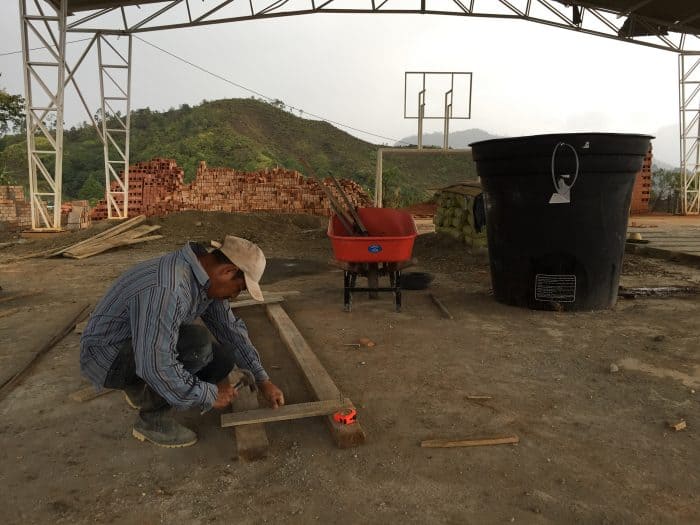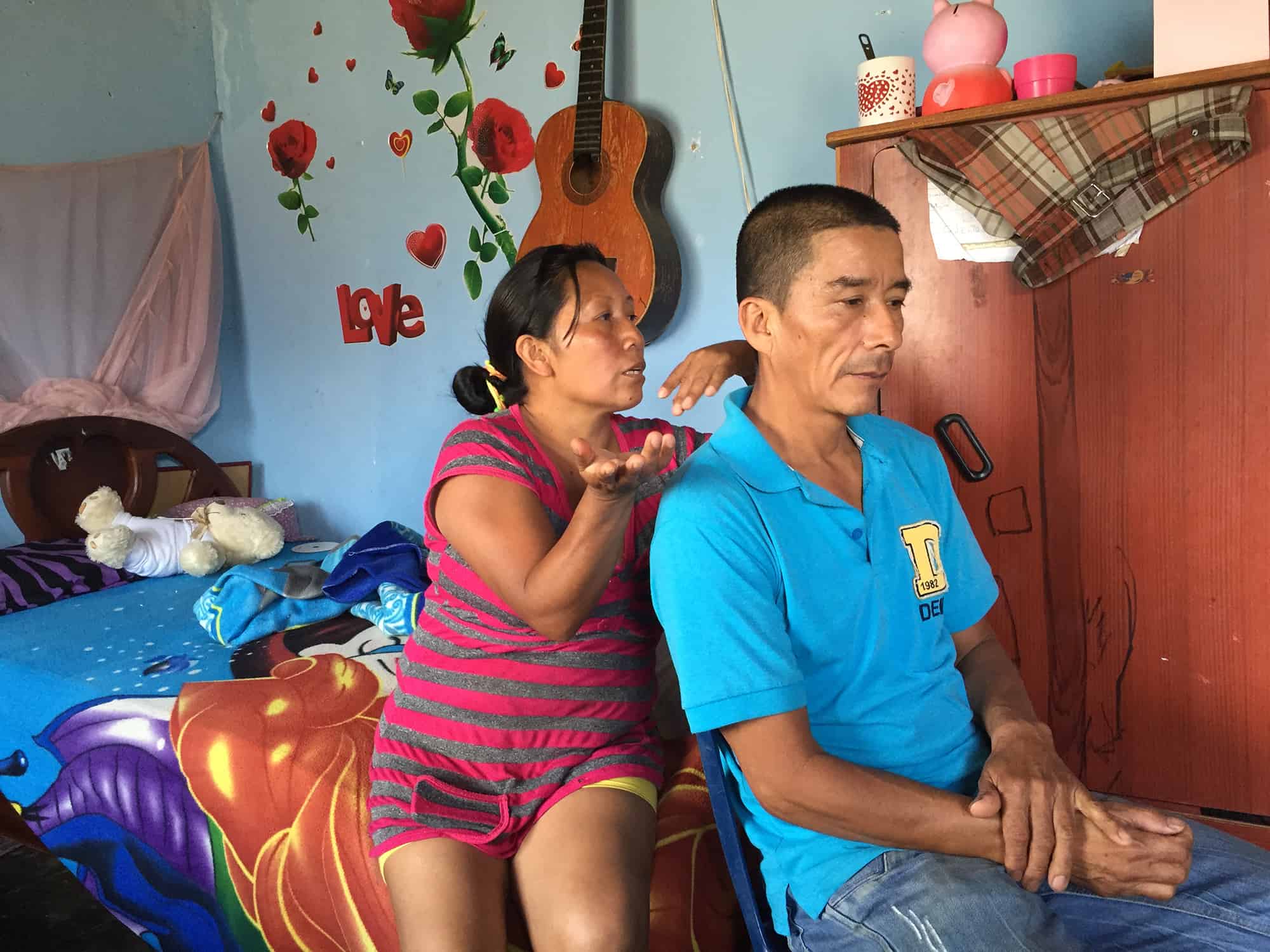LA ESPERANZA, Colombia – Maybe someday, if the truce holds, the covered soccer pitch in this mountain town will become something of a memorial, the precise hilltop spot where Colombian rebels launched their last major attack in a half-century of civil war.
For now, it’s Hugo Rendón’s job to make the world forget. So the foreman is pouring concrete where 11 Colombian soldiers were slaughtered as they bivouacked that rainy night in April. He will be replacing the sheet-metal roof that has so many bullet holes it looks like a planetarium. There will be new bathrooms and a snack bar.
The government is paying for the renovation, but that’s not enough to win the villagers’ trust. Government here means spotty electricity, a poorly equipped health clinic, airplanes spraying chemicals on coca fields. Hanging proudly along the main road that the government hasn’t paved is the tricolor flag of one of the world’s oldest rebel groups – the Revolutionary Armed Forces of Colombia, or FARC.
“They have better ideas than the government, no?” Rendón said.
After three years of discussions in Havana, negotiators for the Colombian government and the rebels have arrived at a place tantalizingly close to peace. By March, President Juan Manuel Santos has pledged, there will be a final accord.
But in the southwestern cordilleras of Cauca province, where thousands have been killed or driven from their homes, the distance to peace seems far greater. Along this rugged Pacific coast, the FARC guerrillas have at times functioned as a shadow state, orchestrating public works projects and demanding loyalty by force.
The insurgency has fed on rural anger at a distant government seen as ruling for the few. In that sense, the toughest fight is yet to come: building a lasting bond between the people and their government.
“We’ve had 50 years of war,” said José Nifer Díaz, a former mayor of Buenos Aires, the municipality that encompasses La Esperanza. “What they’re signing in Cuba is not peace. Each and every one of us has to build our own peace.”

‘A tense calm’
The residents of Buenos Aires, a sleepy farming town shaded by acacia trees, have stepped gingerly into the truce. The cease-fire began last December, broke down after the soccer-field attack, then resumed in the summer. But the guerrillas have not laid down their weapons, nor have soldiers abandoned their posts.
“It’s a tense calm,” said a police officer in town. “They are still armed and hidden and waiting for orders.”
Earlier this year, the United Nations listed 125 municipalities, about 10 percent of the country, with the greatest need for post-conflict rebuilding. One was Buenos Aires. Out of 30,000 people here, nearly one-third have registered as victims of the war. The federal government seems far away, and residents are more accustomed to the rhythms of the guerrillas. Sometimes people get called by the insurgents to clear debris from a road or to listen to a talk by FARC leaders.
“These communities have been abandoned by the state,” said Franklin Ramírez, a municipal employee.
Ramírez hosts community meetings for residents who have lost something in the war. He hands out literature explaining the peace negotiations. Before the truce, bombardments and gun battles rattled the highlands. In town, police would walk in groups. Things have calmed, but risks remain. A young girl leaving school was killed recently after she stepped on a land mine. Gunmen shot at the police station despite the cease-fire.
“The people are scared,” said María Yuli Gómez, a 44-year-old resident forced from her home by the violence. “We haven’t overcome everything that has happened. One still lives with that fear.”
Even if peace holds, the inequalities of rural life will remain. There are few prospects for honest work besides peasant farming on lands of the rich. The guerrillas’ Marxist-inspired ideology still resonates.
“What they’ve always said is they want to help the campesinos,” said Alejandro Ruiz, 42, a coca farmer. “Obviously, we would vote for them.”
But there is also anger that the FARC might suddenly be welcomed as a normal political party, as if the damage it has caused might be forgotten. Resident Vicente Sandoval, 60, laughed bitterly at the prospect of FARC candidates. After the demobilization, he said, the rebels will get health care, jobs, training and housing, “while someone who was peaceful will have nothing.”
Town officials say the federal government must do more to help heal such resentments if the guerrillas are to live openly among the people again.
“If they agree to something in Havana, but we haven’t done the work at the community level, it won’t be worth a thing,” said the municipality’s No. 2 official, Vianey Palacios Carabali.
FARC: A dwindled force
The FARC, as a military threat, is a shadow of its former self. Founded in 1964 as the armed wing of the Communist party in Colombia, its insurgency spread to include tens of thousands of men under arms who controlled wide swaths of the south and east.
In the mid-1980s, the FARC established a political party, the Patriotic Union, with other leftist groups and won hundreds of local government seats and legislative posts. But paramilitary fighters killed more than 2,000 members of the party, including two presidential candidates. In the late 1990s, then-President Andrés Pastrana held peace talks with the guerrillas, but the war raged on.
Santos’ predecessor in the presidency, Álvaro Uribe, launched an aggressive military offensive against the FARC. But the insurgents persisted with sabotage and hit-and-run attacks, blowing up roads, bridges and police stations. Such violence has left them widely unpopular in Colombia, and the FARC has dwindled to about 8,000 fighters. It no longer openly controls territory but operates secretly from rural areas.
The guerrilla group’s greatest challenge is converting itself into a viable political party, said Angelika Rettberg Beil, a political scientist at the University of the Andes in Bogota. “The public is very skeptical about the FARC’s sincerity and desire for peace.”
The peace talks in Havana have cleared many hurdles, but the path forward is daunting. Under the agreement, the government must set up special tribunals to hear combatants’ confessions of their crimes, along with a separate truth commission to take testimony. There are programs to design on crop substitution for the coca plant, rural development and land-mine removal. It is unclear whether the FARC will end up paying reparations to its victims.
Guerrilla foot soldiers not accused of a specific crime are expected to receive amnesty. But the leaders and those facing accusations of serious offenses such as murder or kidnapping will be asked to confess in return for sentences of five to eight years in some type of halfway house or work camp. Prison time is expected to be reserved for those who do not come clean about the past.
“Ending the war is much more than just the laying down of weapons. It’s really accounting for responsibility for the crimes on all sides,” said Bernard Aronson, the U.S. State Department’s representative to the peace talks.
Given their history with the Patriotic Union, the FARC’s leaders are worried about their physical safety as they transition to peaceful politics. Some of the right-wing paramilitary groups formed to battle the rebels have become criminal gangs that the FARC still considers a threat. The guerrillas “want the forces that they believe are their enemies to be dismantled by the government,” Aronson said.
‘Inside a conflict you have nothing to do with’
Ramiro Almendra sat silently in the front row of the victims’ meeting in the Buenos Aires hall of justice. He attends these sessions, riding the bus for an hour from his little hilltop shack, but his hopes of real reparations have dwindled.
Orphaned as a child, he grew up working in coca fields. When right-wing paramilitary fighters swept through the mountain town of Naya in April 2001, intent on emptying villages the guerrillas had moved through, Almendra walked for eight days through the jungle to escape. The massacre was one of the most barbaric of the war; paramilitary troops used chain saws and machetes to slaughter dozens of farmers.
Almendra settled on a chilly ridge with a view of the Pacific. With his wife, Rosa Delia Fernández, he started selling coffee and fritters to mule-drivers trekking through. Over the next decade, they built a crude wood house, which doubled as a restaurant and inn, that they named the Mirador. But FARC rebels used the area, too. When Colombian soldiers entered the town, they accused him of harboring terrorists in his hotel.
“You feed the guerrillas, then you’re an accomplice. You sell a juice to the soldiers, then you’re collaborating with the army,” Delia said. “You find yourself inside a conflict you have nothing to do with.”
By the summer of 2012, the Colombian military was bombarding the forested hills around their house. One night, with a helicopter hovering above their roof and the children sobbing, they decided to flee. It has been three years, and they don’t feel safe enough to return.
Almendra is not yet betting on peace.
“The government has to apologize to the campesinos, to the people, because they’ve done a lot of damage,” he said. “And the guerrillas have to do the same. They have to say they are sorry to all those they have harmed.”
© 2015, The Washington Post






